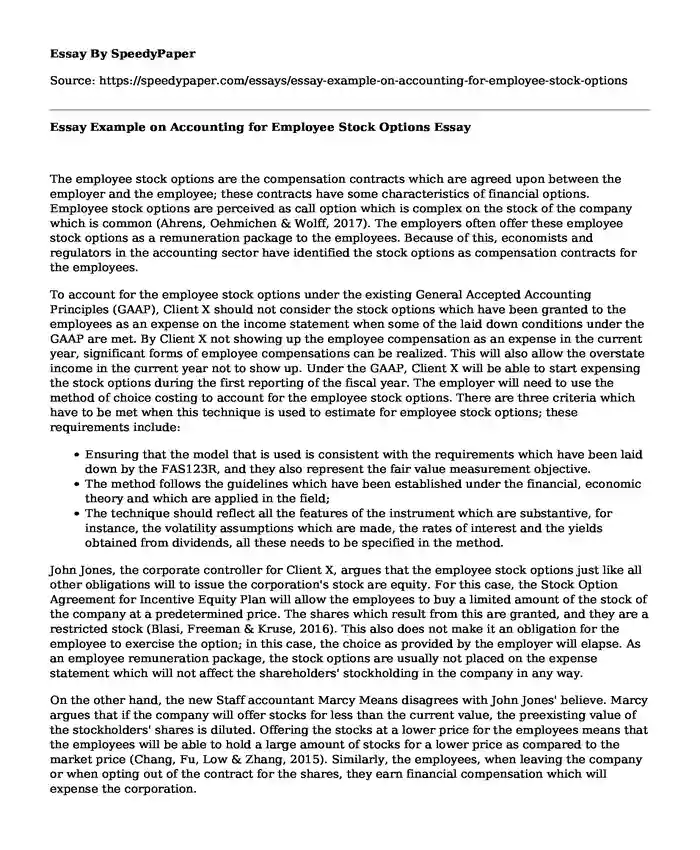
| Type of paper: | Essay |
| Categories: | Contract Employment Accounting |
| Pages: | 3 |
| Wordcount: | 663 words |
The employee stock options are the compensation contracts which are agreed upon between the employer and the employee; these contracts have some characteristics of financial options. Employee stock options are perceived as call option which is complex on the stock of the company which is common (Ahrens, Oehmichen & Wolff, 2017). The employers often offer these employee stock options as a remuneration package to the employees. Because of this, economists and regulators in the accounting sector have identified the stock options as compensation contracts for the employees.
To account for the employee stock options under the existing General Accepted Accounting Principles (GAAP), Client X should not consider the stock options which have been granted to the employees as an expense on the income statement when some of the laid down conditions under the GAAP are met. By Client X not showing up the employee compensation as an expense in the current year, significant forms of employee compensations can be realized. This will also allow the overstate income in the current year not to show up. Under the GAAP, Client X will be able to start expensing the stock options during the first reporting of the fiscal year. The employer will need to use the method of choice costing to account for the employee stock options. There are three criteria which have to be met when this technique is used to estimate for employee stock options; these requirements include:
- Ensuring that the model that is used is consistent with the requirements which have been laid down by the FAS123R, and they also represent the fair value measurement objective.
- The method follows the guidelines which have been established under the financial, economic theory and which are applied in the field;
- The technique should reflect all the features of the instrument which are substantive, for instance, the volatility assumptions which are made, the rates of interest and the yields obtained from dividends, all these needs to be specified in the method.
John Jones, the corporate controller for Client X, argues that the employee stock options just like all other obligations will to issue the corporation's stock are equity. For this case, the Stock Option Agreement for Incentive Equity Plan will allow the employees to buy a limited amount of the stock of the company at a predetermined price. The shares which result from this are granted, and they are a restricted stock (Blasi, Freeman & Kruse, 2016). This also does not make it an obligation for the employee to exercise the option; in this case, the choice as provided by the employer will elapse. As an employee remuneration package, the stock options are usually not placed on the expense statement which will not affect the shareholders' stockholding in the company in any way.
On the other hand, the new Staff accountant Marcy Means disagrees with John Jones' believe. Marcy argues that if the company will offer stocks for less than the current value, the preexisting value of the stockholders' shares is diluted. Offering the stocks at a lower price for the employees means that the employees will be able to hold a large amount of stocks for a lower price as compared to the market price (Chang, Fu, Low & Zhang, 2015). Similarly, the employees, when leaving the company or when opting out of the contract for the shares, they earn financial compensation which will expense the corporation.
References
Ahrens, C., Oehmichen, J., & Wolff, M. (2017). The impact of stock-based incentives on employee behavior and the moderating effect of institutions. In Academy of Management Proceedings (Vol. 2017, No. 1, p. 12132). Briarcliff Manor, NY 10510: Academy of Management. https://doi.org/10.5465/AMBPP.2017.12132abstract
Blasi, J., Freeman, R., & Kruse, D. (2016). Do broadbased employee ownership, profit sharing and stock options help the best firms do even better? British Journal of Industrial Relations, 54(1), 55-82. https://doi.org/10.1111/bjir.12135
Chang, X., Fu, K., Low, A., & Zhang, W. (2015). Non-executive employee stock options and corporate innovation. Journal of financial economics, 115(1), 168-188. https://doi.org/10.1016/j.jfineco.2014.09.002
Cite this page
Essay Example on Accounting for Employee Stock Options. (2022, Dec 14). Retrieved from https://speedypaper.com/essays/essay-example-on-accounting-for-employee-stock-options
Request Removal
If you are the original author of this essay and no longer wish to have it published on the SpeedyPaper website, please click below to request its removal:
- Free Essay on Wendy's and McDonald's Organizational Cultures
- Treatment of Schizophrenia - Essay Example
- Free Essay on Different Market Structures for Businesses and Consumers.
- Catholic Crisis Points - Free Essay in Religion
- Ethical Police Administration, Essay Example for Students
- Law Essay Example: Kuketz v. Petronelli (2005)
- The Virginia Plan and Other Prominent Documents, Free Essay in American History
Popular categories




